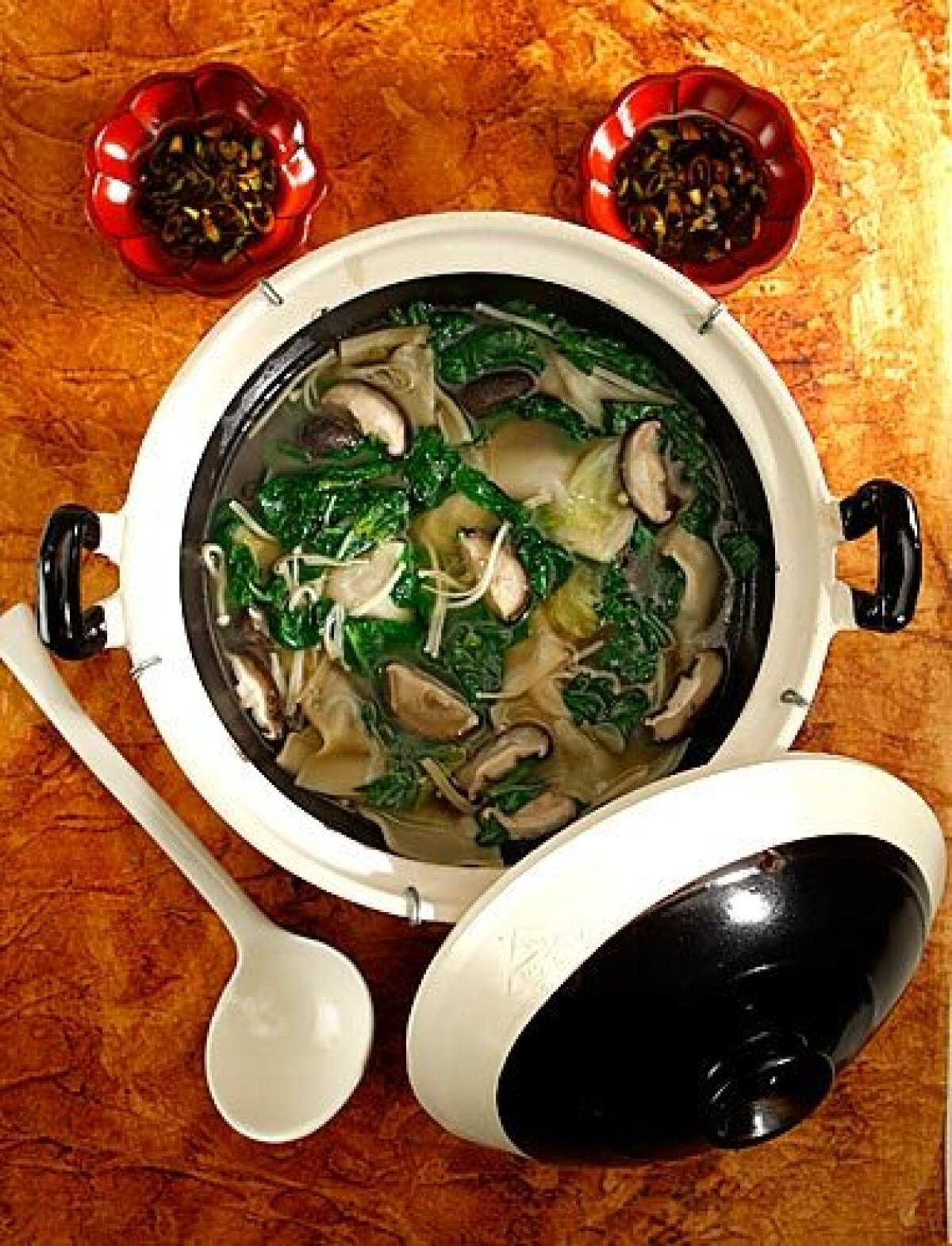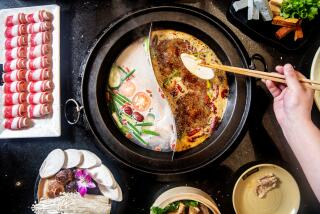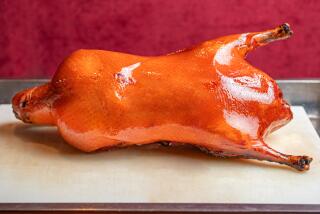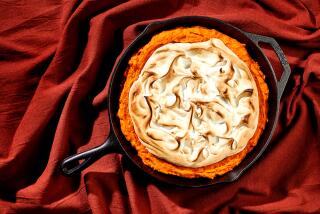Recipe: Duck gyoza hot pot

- Share via
Duck gyoza hot potTotal time: 1 hour, 20 minutesServings: 4 to 6Note: Adapted from “Japanese Hot Pots” by Tadashi Ono and Harris Salat. White miso (soy bean paste), nira (garlic chives), ra yu (chile oil), konbu (kelp for stock) and negi (Japanese green onion) are available at Japanese markets. Look for the thickest won ton skins you can find so that they hold together as they cook; you can find them at select well-stocked supermarkets.Duck gyozaSalt1 cup finely chopped green cabbage (about 4 ounces) 1/2 pound (1 medium) boneless duck breast with skin, coarsely chopped3 tablespoons chopped green onions1 teaspoon chopped fresh ginger1 clove garlic, chopped1 tablespoon sake1 tablespoon shiro (white) miso 1/4 cup finely chopped garlic chives (nira, about 1 ounce)1 package (about 50 skins) round wonton skins1 teaspoon cornstarch mixed with 1/2 cup warm water1. In a medium bowl, lightly salt the chopped cabbage and toss to mix well, then set aside for 15 minutes. In batches, place the cabbage on a clean kitchen towel and wring the towel over the sink to squeeze out excess moisture. Set aside.2. In the bowl of a food processor, place the duck, green onions, one-fourth teaspoon salt, ginger, garlic, sake and miso. Pulse just until the mixture becomes a coarse paste. Transfer to a mixing bowl and fold in the reserved cabbage and the garlic chives, mixing well.3. To assemble the gyoza, place a wonton skin in the palm of one hand. Spoon 2 teaspoons of the gyoza mixture onto the center of the wonton skin. With your finger, wet the wonton skin’s edges with the cornstarch-water mixture. Fold the skin in half and pinch it together, pressing out the extra air before sealing the skin. (The cornstarch will “glue” the wonton skin together.)4. Place the gyoza on a plate and repeat with the rest of the mixture, which will make about 25 pieces. Keep the wonton skins covered with a moist paper towel while you work, so they don’t dry out. Set the gyoza aside.Dipping sauce4 tablespoons soy sauce2 tablespoons rice vinegar1 tablespoon ra yu (chile oil, also called la yu)2 tablespoons thinly sliced scallionsTo make the dipping sauce, combine the soy sauce, rice vinegar, chile oil and green onions in a small bowl. Set aside.Hot pot assembly2 (6-by-3-inch) pieces konbu (kelp)5 cups chicken broth 1/2 cup sake1 teaspoon salt 1/2 pound nappa cabbage, sliced crosswise on an angle into 2-inch pieces1 negi (Japanese green onion), sliced on an angle into 2-inch pieces4 ounces shiitake mushrooms (about 8 pieces), stems removed and halved3 1/2 ounces (about half of a 200-gram package) enoki mushrooms, trimmed and pulled apartDuck gyoza 1/4 pound spinach, stemmedDipping sauce1. In the bottom of a pot (such as a Japanese clay donabe or cast-iron Dutch oven), place the konbu. Add the chicken broth, sake and salt, and bring to a boil over high heat. Remove the konbu and discard. Reduce the heat to a simmer and add the nappa cabbage, negi, shiitake mushrooms and enoki mushrooms and cook for 2 minutes. Add the gyoza to the hot pot, making sure they’re submerged in the broth. Continue to simmer until the gyoza are cooked through, 5 to 10 minutes (check by opening one up at the 5-minute mark). Add the spinach and simmer for 1 minute more.2. While the hot pot simmers, fill four small bowls with the dipping sauce. Transfer the hot pot to the dining table. Dip the ingredients into the sauce-filled bowls, and eat. Add more dipping sauce to the bowls as needed.3. Alternatively, this can be cooked tableside with a portable gas burner: Arrange the ingredients on serving platters. After preparing the gyoza and dipping sauce, do all the cooking at the dining table. Add the supporting ingredients all at once, or reserve half or more to cook later. Cook a few of the gyoza at a time.Each of 6 servings: 237 calories; 12 grams protein; 30 grams carbohydrates; 4 grams fiber; 5 grams fat; 1 gram saturated fat; 22 mg. cholesterol; 2 grams sugar; 1,715 mg. sodium.
More to Read
Eat your way across L.A.
Get our weekly Tasting Notes newsletter for reviews, news and more.
You may occasionally receive promotional content from the Los Angeles Times.










